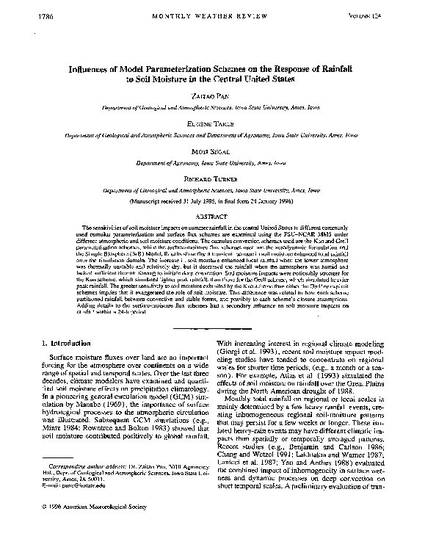
The sensitivities of soil moisture impacts on summer rainfall in the central United States to different commonly used cumulus parameterization and surface flux schemes are examined using the PSU-NCAR MMS under different atmospheric and soil moisture conditions. The cumulus convection schemes used are the Kuo and Grell parameterization schemes, while the surface-moisture flux schemes used are the aerodynamic formulation and the Simple Biosphere (SiB) Model. Results show that a transient increase in soil moisture enhanced total rainfall over the simulation domain. The increase in soil moisture enhanced local rainfall when the lower atmosphere was thermally unstable and relatively dry, but it decreased the rainfall when the atmosphere was humid and lacked sufficient thermal forcing to initiate deep convection. Soil moisture impacts were noticeably stronger for the Kuo scheme, which simulated lighter peak rainfall, than those for the Grell scheme, which simulated heavier peak rainfall. The greater sensitivity to soil moisture exhibited by the Kuo scheme than either the Grell or explicit scheme implies that it exaggerated the role of soil moisture. This difference was related to how each scheme partitioned rainfall between convective and stable forms, and possibly to each scheme's closure assumptions. Adding details to the surface-moisture flux schemes had a secondary influence on soil moisture impacts on rainfall within a 24-h period.
Available at: http://works.bepress.com/eugene-takle/89/

This article is published as Pan, Zaitao, Eugene Takle, Moti Segal, and Richard Turner. "Influences of model parameterization schemes on the response of rainfall to soil moisture in the central United States." Monthly Weather Review 124, no. 8 (1996): 1786-1802. DOI:10.1175/1520-0493(1996)124<1786:IOMPSO>2.0.CO;2. Posted with permission.